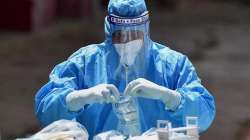Indian-origin scientist among UBC researchers unveil world’s 1st molecular-level analysis of Omicron
Dr Sriram Subramaniam, professor in UBC faculty of medicine’s department of biochemistry and molecular biology, said that Omicron has greater binding affinity than the original SARS-CoV-2 virus, with levels more comparable to what seen with the Delta variant.

A team of researchers, including an Indian-origin scientist at the prestigious University of British Columbia, has become the first in the world to conduct a molecular-level structural analysis of the Omicron spike protein, which could help accelerate the development of more effective treatments against the variant. Spike protein helps the virus enter and infect cells.
Dr Sriram Subramaniam, professor in UBC faculty of medicine’s department of biochemistry and molecular biology, said that Omicron has greater binding affinity than the original SARS-CoV-2 virus, with levels more comparable to what seen with the Delta variant.
The findings, published in the Science journal, sheds new light on why Omicron is highly transmissible and will help accelerate the development of more effective treatments, according to a statement issued by the Vancouver-based university. The analysis, done at near atomic resolution using a cryo-electron microscope, reveals how the heavily mutated variant infects human cells and is highly evasive of immunity,
Subramaniam discussed the implications of his team’s research and underlined that “vaccination remains our best defence against the Omicron variant”.
The findings show strong antibody evasion and binding with human cells that contribute to increased transmissibility, and that vaccination remains the best defence, the university said.
“UBC researchers are the first in the world to conduct a molecular-level structural analysis of the Omicron variant spike protein,” it said.
Subramaniam said: “the Omicron variant is unprecedented for having 37 spike protein mutations, that’s three to five times more mutations than any other variant we’ve seen”.
This is important for two reasons. Firstly, because the spike protein is how the virus attaches to and infects human cells. Secondly, because antibodies attach to the spike protein in order to neutralise the virus, he said.
“Therefore, small mutations on the spike protein have potentially big implications for how the virus is transmitted, how our body fights it off, and the effectiveness of treatments. Our study used cryo-electron microscopy and other tests to understand how mutations impact the behaviour of the Omicron variant at a molecular level,” Subramaniam said.
He said that several mutations (R493, S496 and R498) create new salt bridges and hydrogen bonds between the spike protein and the human cell receptor known as ACE2. This appears to increase binding affinity, how strongly the virus attaches to human cells, while other mutations (K417N) decrease the strength of this bond, Subramaniam said.
He said it is remarkable that the Omicron variant evolved to retain its ability to bind with human cells efficiently despite such extensive mutations. “Our experiments confirm what we’re seeing in the real world, that the Omicron spike protein is far better than other variants at evading monoclonal antibodies that are commonly used as treatments, as well as at evading the immunity produced by both vaccines and natural infection,” he said.
Notably, Omicron was less evasive of the immunity created by vaccines, compared to immunity stemming from natural infection in unvaccinated COVID-19 patients, he said. Both the characteristics seen as a result of spike protein mutations, strong binding with human cells and increased antibody evasion, are likely contributing factors to the increased transmissibility of the Omicron variant, he said.
These are the underlying mechanisms fuelling the variant’s rapid spread and why Omicron could become the dominant variant of SARS-CoV-2 very quickly, he said.
“The good news is that knowing the molecular structure of the spike protein will allow us to develop more effective treatments against Omicron and related variants in the future. Understanding how the virus attaches to and infects human cells means we can develop treatments that disrupt that process and neutralise the virus.
“An important focus for our team is to understand better the binding of neutralising antibodies and treatments that will be effective across the entire range of variants, and how those can be used to develop variant-resistant treatments,” Subramaniam added. Omicron was first identified in South Africa and Botswana in November and is driving the current wave of infections.
Also Read | Staying at isolation facility not mandatory from today for foreign arrivals testing COVID positive
Also Read | COVID: Britain lifts restrictions, says omicron wave ‘has peaked’